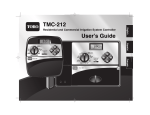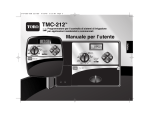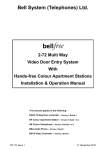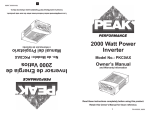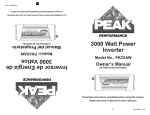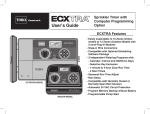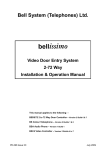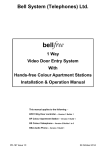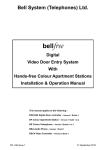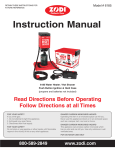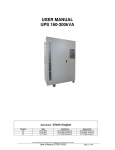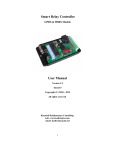Download TMC-212TM User's Guide - Turf Care Products Canada
Transcript
TMC-212 TM Residential and Commercial Irrigation System Controller User’s Guide Congratulations! You have chosen one of the most sophisticated and technologically advanced irrigation system controllers available for residential and light-commercial applications. Your new Toro TMC-212 controller features: Flexible Station Count from 2 to 12 Stations with 2-station Expansion modules Standard and High-surge Expansion Modules Locking Outdoor Cabinet Automatic Pump Start/Master Valve Control Circuit 365-day Calendar 3 Fully-independent Watering Programs 4 Start Times per Watering Day 3 Watering day Schedule Options: 7-day Calendar 7-day Interval with Day Exclusion Odd/Even Days with Day Exclusion Station Time from 1 minute to 4 hours Pump Start/Master Valve Timing Control Well Recovery/Station Delay Time Season Adjust from 10 to 200 % Rain Delay from 17 Days Automatic Program/Start Time Stacking Rain Sensor Ready Compatible with All Rain Sensor Types Sensor Circuit Bypass Switch Remote Control Ready Automatic Circuit Protection - Eliminates Fuse Non-volatile Program Memory - Eliminates Battery The TMC-212 has some unique features and operating characteristics. Take just a few minutes to browse through this manual and familiarize yourself with the TMC-212 components, installation requirements and operating features. The User’s Guide is divided into six main sections: • The first section provides a brief description of the controller components and display elements. • The second section takes you step-by-step through t he installation process. • The next section provides fundamental irrigation system operation, basic controller operation as well as specific programming and operating characteristics of the TMC-212. • The fourth section takes you step by step through the programming process. • The fourth section explains the various methods of automatic and manual controller operations. • An appendix provides various reference information, specifications and warranty information. A watering schedule form (affixed to the cover of the outdoor model cabinet and included on page 20 of the User’s Guide for the indoor model) provides a convenient place to record the location of each watering station area and specific details of your automatic watering programs. Table of Contents Controller Components ...................................2 ■ Controller Installation ■ ■ ■ ■ Indoor Model Installation ................................6 ❚ Connecting the Valves ....................................7 ❚ Connecting a Pump Start Relay......................8 ❚ Connecting the Transformer ...........................8 Outdoor Model Installation .............................9 ❚ Preparing the Cabinet for Installation..............9 ❚ Installing the Cabinet.....................................10 ❚ Connecting the Valves ..................................11 ❚ Connecting a Pump Start Relay....................12 ❚ Connecting the Power Source ......................13 Connecting a Rain Sensor...............................13 ■ ■ Controller Operations ■ ■ Getting Started ■ ■ ■ ■ ■ Irrigation System Basics ..................................14 Watering Program Basics ................................15 Watering Program Details................................16 Planning Your Watering Schedule...................18 Filling Out the Watering Schedule Form..........18 ❚ Watering Schedule Form ..............................20 Programming the Controller ■ ■ ■ About the Controller Memory...........................21 Setting the Current Time and Day or Date ......21 Setting the Watering Day Schedule.................22 ❚ Setting a Calendar Schedule ........................22 ❚ Setting an Interval Schedule .........................23 ❚ Setting an Odd or Even Schedule.................24 ❚ Using the Day Exclusion Feature .................25 Turning Off a Program ....................................26 Setting Program Start Times ...........................27 Setting Station Times.......................................28 Setting Pump/Master Valve and Well Recovery Controls ...................................28 ■ ■ ■ Automatic Mode ............................................30 Manual Mode .................................................31 ❚ Operate Watering Program(s).......................31 ❚ Operate Stations ...........................................31 ❚ Watering Control Features ............................32 ❚ Pause Watering ..........................................32 ❚ Resume Watering .......................................32 ❚ Cancel Watering .........................................32 ❚ Skip Stations ...............................................32 ❚ Adjust the Station TIme During Operation ..33 Rain Delay Feature..........................................33 Season Adjust Feature ....................................34 Turn Off Operation...........................................35 Appendix ■ ■ ■ ■ ■ ■ ■ ■ Clearing the Program Memory.........................36 About Automatic Circuit Protection ..................37 Adding a 2-Station Expansion Module.............37 Using Pump/Master Valve Controls.................38 Troubleshooting ...............................................40 Specifications...................................................41 Warranty ..........................................................42 Electromagnetic Compatibility .........................42 1 Controller Components Controller Components 2 Controller Components The following are brief descriptions of the controller components and display elements. Each of these items will be explained in further detail within the appropriate programming, operating and installation sections of this guide. 1 - LCD Display 2 - Control Buttons +/ON button – Increases the time display, scrolls forward through the program information and selects watering days. –/OFF button – Decreases the time display, scrolls backward through the program information and removes watering days. A - “Start Time” symbol is displayed when setting the program start times. NEXT button – Advances to the next portion of program information. Resumes watering if paused. Advances through stations manually when watering. B - “Well Recovery” symbol is displayed when well recovery time delay is in use. MANUAL START C - Program start time identification numbers 1–4. D - Main display of various time values and prompts. E - Program A, B and C identifiers. F - “Watering On” symbol is displayed when a watering station is running. Symbol blinks when watering is paused. G - “Watering Off” symbol is displayed when Rain Delay feature is active. H - “Percent” symbol is displayed when the Season Adjust feature is in use. I - Watering Station identification numbers. J - Day of the week identifiers. K - “Run Time” symbol is displayed when setting the watering station run times. button – Selects and starts manual watering operations. 3 - Control Dial – Selects all controller programming and operation controls (except Manual Start). Control Dial Positions – The normal dial position for all automatic and manual operations. RUN CURRENT TIME/DAY – Enables the clock time and day to be set. WATERING DAYS – Enables the watering day schedules to be set and reviewed. – Enables the program start times to be set and reviewed. START TIMES – Enables the station run time to be set and reviewed. STATION TIMES (continued) 3 Controller Components 3 - Control Dial Positions (continued) SEASON ADJUST – Enables the station time of all stations in a program to be simultaneously increased or decreased in 10% increments. – Provides optional control and timing features for pump operation and well recovery delay feature. SPECIAL FUNCTIONS – Enables all watering operations to be delayed from 1 to 7 days. RAIN DELAY – Shuts off and prevents all automatic and manual watering activity. OFF 4 - Program Select Switch – Three-position slide switch used to select watering program A, B or C during the programming procedures and manual operation. 11 - 2-Station Expansion Module – Each 2-station expansion module provides connections for two irrigation control valves. Up to 6 modules for a total of 12 stations can be installed. Provides 1.3 Kv surge protection on each output. 12 - Remote Control Receiver Jack – Modular jack provided for the connection of an optional Toro Remote Control receiver cable. (Installation and operating instructions are provided with the Toro Remote Control system.) 13 - External Transformer – A Plug-in transformer supplies 24 VAC power for the indoor controller models. 5 - Rain Sensor Circuit Control Switch – Enables the Rain Sensor circuit to be bypassed as necessary. 14 - Internal Transformer – A built-in transformer supplies 24 VAC power to the outdoor controller models. 6 - Rain Sensor Configuration Switch – Configures the controller for operation with a Normally-open or a Normally-closed rain sensor. 15 - Input Power Terminal Block – Connection terminals for AC power wires. 7 - Rain Sensor Connection Terminals – Snap-in wire connectors for direct connection of a Rain Sensor. 8 - Valve Common Connection Terminal – Snap-in wire connector for the valve common wire. 9- 4 10 - Transformer Connection Terminals – Snap-in connectors for transformer wires. Pump/Master Valve Connection Terminal – Snap-in wire connector for connection of a pump start relay or master valve 24 VAC power wire. 16 - High-surge 2-station Expansion Module – Each 2-station expansion module provides connections for two irrigation control valves. Up to 6 modules for a total of 12 stations can be installed. Provides 6.0 Kv surge protection on each output. Note: This module can only be used in high-surge outdoor controller models. Controller Components 5 A Controller Installation F CAUTION: TMC-212 indoor controller models are not weather resistant and must be installed indoors or in a protected location. B Indoor Model Installation C 1. Select a location for the controller within 4' (1.2m) of an electrical outlet to enable the transformer wires to easily reach. Make sure the outlet is not controlled by a light switch. 2. Remove the mounting bracket attached to the back of the controller housing by pulling the lower edge of the bracket away and downward from the controller housing. 3. Place the mounting bracket (A) against the wall aligning the top edge at about eye level. Drive three 1" (25mm) wood screws (B) into the wall through the three holes provided in the bracket. Note: If you are installing the bracket on drywall or masonry, install screw anchors (C) to prevent screws from loosening. 4. Optional - Insert 3/4" (19mm) PVC conduit (D) for valve wiring into bracket sleeve (E). 5. Align the slotted openings on the back of controller housing with the mounting bracket tabs. Slide the controller downward to engage the tabs. 6 E D Note: After installation, store the Quick Reference Guide and the Watering Schedule Form in the pocket (F) behind the controller. Connecting the Valves 11 2. Attach the white-color cable wire to one wire from each valve solenoid. (Either solenoid wire can be used for this connection.) This is called the valve common wire. 3. Attach a separate cable wire to the remaining wire from each valve solenoid. Make a note of the wire color code used for each valve and the watering station it controls. You will need to have this information when connecting the valve wires to the controller. 4. Secure all wire splices using twist-on wire connectors. To prevent corrosion and possible short circuits, use a grease cap or similar waterproofing method to insulate each connection. 5. Route the wire cable into the controller through the large opening in the base of the housing or through PVC conduit if it is installed. Strip insulation back 1/2" (13mm) from all cable wires. DIS ENB NO Note: The station modules and wire connectors accept 14–18 AWG (2.5–1.0mm2).solid-core copper wire. Sprinkler system connection cable is recommended. NC 1. Route the valve control wires between the valves and the controller. 8 9 Master Valve Valve Common Wire Station Valves 6. Referring to the Controller Components on page 5 and the diagram above, secure the valve common wire to the terminal labeled COM (8). Connect the individual station valve wires to the appropriate station module terminals (11). Connect the master valve wire (if applicable) to the terminal labeled PUMP/MV (9). Note: Connecting a master valve or pump start relay is optional and may not be required in your sprinkler system. Note: The station module has snap-in wire connectors To attach wires, simply raise the lever and insert the bare wire end into the small hole beneath the lever. Press the lever down to secure the wire. Pull lightly on the wire to confirm that it is locked into the module. 7 Connecting a Pump Start Relay Connecting the Plug-in Transformer CAUTION: Never connect an auxiliary pump starter directly to the controller. A 24 VAC relay, rated at 0.30A maximum current draw, must be used to connect the controller to the pump starter circuit. 1. Route a wire pair from the pump start relay into the controller housing. 2. Connect one wire to the valve common COM (8). Connect the remaining wire to the PUMP/MV (9) as shown below. 1 2 3 4 5 6 7 8 CAUTION: Do not plug the transformer into an electrical outlet until all of the wiring procedures have been completed. 1. Route the cable from the transformer (13) through the small opening provided in the base of the housing. Wrap the cable around and through the restraining post as shown below. 10 9 Jumper Wire 8 9 9V 24 VAC Pump Start Relay Valve Common Wire CAUTION: If the pump does not have an automatic pressure control switch, prevent pump damage due to “dead-heading,” by connecting a jumper wire from any unused station terminal to a station terminal with a valve wire connected. 8 13 Note: Refer to “Pump Control and Well Recovery” section on page 28 for important pump circuit control information. 2. Connect one transformer cable wire to each terminal labeled 24 VAC (10). The wires can be connected to either terminal. Note: The display will begin flashing 12:00 a.m. Press any button to stop the display from flashing. Outdoor Model Installation ON ON MA MANUNUAL ST AL STARAR T T NE NEXTXT B OF OFF F C A Preparing the Cabinet for Installation 1. Remove the lower housing cover (A) by pulling outward on the handle. 2. Remove two phillips screws from the transformer access cover (B). Pull the cover outward from the bottom to remove. 3. Three lower mounting holes (C) are provided. The center hole is open and the outer holes are plugged. If you intend to use the outer holes for installation, carefully drill through the plugs with a 3/16" (5mm) drill bit. D E F G Four wiring access holes are provided in the cabinet base as follows: (D) - 1/2" (13mm) for power and equipment ground wires. (E) - 1/2" (13mm) (plugged) for optional Toro Rain Sensor wires. (F) - 3/4" (19mm) for sprinkler valve wires. (G) - 1/2" (13mm) (plugged) for optional Toro remote control cable. 4. If planning to install the optional Toro components, remove the plugs as necessary. 9 Installing the Cabinet 1. For safe, reliable operation, select an installation site which will provide the following conditions: • Protection from irrigation spray, exposure to direct sun during the hottest hours, wind and snow. • Access to a grounded power source which is not controlled by a light switch or utilized by a high current load appliance, such as a refrigerator or air conditioner. • Access to the sprinkler control valve wiring and optional accessory wiring. A B 6" (15.24cm) 2. Drive a wood screw (provided) into the wall at eye level (A). Leave the screw extended approximately 1/4" (6.5mm) from the wall. Note: If you are installing the controller on drywall or masonry, install screw anchors to prevent screws from loosening. Use the dimension shown to predrill holes for screw anchors. 3. Hang the cabinet on the screw using the keyhole slot (B) on the back panel. Make sure the cabinet slides down securely on the screw. 4. Install the lower mounting screw(s) and tighten securely. Note: Conduit and adapters are not provided. Install conduit as required by local electrical codes. 5. Install 1/2" (13mm) conduit (C) for power/equipment ground wires and 3/4" (19mm) conduit (D) for valve wires. 10 Note: After installation, store the User’s Guide and Quick Reference Guide on the hook located on the inside of the door. C D Connecting the Valves Note: Using 16 to 18 AWG (1.5mm2 to 1mm2) irrigation cable is recommended. This cable is made specifically for automatic irrigation systems and is available in several lengths and conductor count. Always use a cable that has at least one wire for each valve and one wire for the valve common connection. 1. Route the wire cable from the valve location into the controller cabinet. IMPORTANT: The TMC-212 has snap-in wire terminals. To attach wires, simply raise the lever, insert the stripped end of the wire, then press the lever down to secure the connection. After securing a wire, inspect the connection to verify a small portion of bare wire is visible to ensure that insulation is not present in the wire contact area. 11 2. Attach the white color-coded cable wire to one wire from each valve solenoid. This is called the valve common wire. Note: The solenoid does not have specific polarity, so either wire can be used for the common wire connection). 3. Connect an individual color-coded cable wire to the remaining solenoid wire of each valve. Make a note the wire insulation color used for each valve connection and the sprinkler zone controlled by the valve. IMPORTANT: Properly insulate and waterproof all solenoid wire connections and cable wire splices to prevent short circuit conditions. 4. Remove 1/2" (13mm) of insulation from the end of all cable wires to be connected to the controller. 8 9 Master Valve Valve Common Wire Station Valves 5. Referring to the Controller Components on page 5 and the diagram above, secure the valve common wire to the terminal labeled COM (8). Connect the individual valve wires to the appropriate expansion module terminals (11). The stations are numbered from left to right, 1 through 12. Connect the master valve wire (if applicable) to the terminal labeled PUMP/MV (9). 11 Connecting a Pump Start Relay CAUTION: To prevent controller damage, never connect an auxiliary pump starter directly to the controller’s 24 VAC output. A 24 VAC 0.30A relay, must be used to connect the controller to the pump starter circuit. 1. Route a wire pair from the pump relay into the controller housing. 2. Connect one wire to the terminal labeled COM (8). Connect the remaining wire to the terminal labeled PUMP/MV (9) as shown below. Jumper Wire 8 Connecting the Power Source WARNING: AC power wiring must be installed and connected by qualified personnel only. All electrical components and installation procedures must comply with all applicable local and national electrical codes. Some codes may require a means of disconnection from the AC power source installed in the fixed wiring and having a contact separation of at least 0.120" (3mm) in the line and neutral poles. Make sure the power source is OFF prior to connecting the controller. 1. Route the power and equipment ground wires from the power source, through the conduit and into the controller transformer compartment. Note: The controller terminal block accepts wire size up to 12 AWG (4mm2). 9 2. Remove 3/8" (10mm) insulation from the wire ends. Pump Start Relay Valve Common Wire CAUTION: To prevent pump damage due to prolonged dead-head pressure, connect a jumper wire from an unused station terminal to a terminal with a with a valve connected. 12 Note: Refer to “Pump Control and Well Recovery” section on page 28 for important pump circuit control information. 3. Using a small flat blade screwdriver, secure the wires as shown to the terminal block as follows: Line or Line 1 (L1) to L, Neutral or Line 2 (L2) to N and Equipment Ground to . 4. Install and secure the transformer compartment cover. 5. Apply power to the controller. Note: The display will begin flashing 12:00 AM. Press any button to stop the display from flashing. Connecting the Power Source (cont.) Toro Wireless Rain Sensor 5 5 6 6 Connecting a Rain Sensor (optional) A rain sensor is an optional control device that connects directly to the TMC-212 to automatically interrupt automatic controller operation during rain. A sensor bypass switch is provided to enable sensor operation to be disabled as needed. A sensor configuration switch enables the controller to work with a normally-open or a normally-closed rain sensor. When the rain sensor absorbs moisture it signals the TMC-212 to suspend automatic watering operations. The “No Watering” symbol is displayed until the sensor drys out and automatically resets. The symbol will disappear and controller operation will resume as programmed. 1. Route the sensor wires from the device into the controller housing through the access hole provided. 2. Remove the plastic insert from the Sensor terminal connectors. Connect sensor wires per the instructions provided with the device. 3. Set the Sensor Configuration Switch (5) to NC (Normally Closed) or NO (Normally Open) operation as required by the type of sensor connected. 4. Set the Sensor Control Switch (6) as required: ENB (enable) allows the rain sensor to interrupt watering; DIS (disable) bypasses the rain sensor input. IMPORTANT: Do not use the ENB switch position with the NC switch position unless a normallyclosed rain sensor is connected. Watering operation will be suspended if this condition occurs. 5. Refer to the instructions provided with the rain sensor for operating information. 13 Getting Started – Irrigation System Basics The three major components of every automatic sprinkler system are the controller, the control valves and the sprinklers/emitters. The controller is the brain of the system, signaling each control valve when and how long to open. The valves are connected to numbered terminals within the controller, and identified as Station 1, Station 2, etc. Each station controls a group of sprinklers in a specific portion of the landscape called a watering “Zone.” The zones are generally laid out according to the type of plant material being watered and the type and flow rate of the sprinklers used to distribute the water. Automatic controller “Programs” are used to establish and organize different watering schedules. The TMC-212 provides three independent watering programs, designated A, B and C. and are established by specifying: what day(s) of the week to water – called watering days, what time to start watering – called start time and how long each station runs – called station time. Each station can be assigned to each program and have a different amount of run time in each program. When an automatic program starts, each station with an assigned run time in the program will operate one by one in numeric sequence from lowest to highest station number Controller Valve 1 Valve 2 Valve 3 House Valve 4 Valve 5 Valve 1 - Station 1 - Parkway Lawn - Fixed Spray Valve 2 - Station 2 - Front Lawn - Fixed Spray Valve 3 - Station 3 - Front Shrubs - Flood Bubbler Valve 4 - Station 4 - Back Lawn - Geared Rotor Valve 5 - Station 5 - Garden - Drip 14 Watering Program Basics The following example illustrates how a typical watering program could be set up for the sprinkler system shown on the previous page. The diagram at the right depicts the watering program in a timeline format. Example: The program start time is set for 3:00 a.m. Lawn stations 1 and 2 each have a run time of 10 minutes and lawn station 4 is set to run for 20 minutes. Note that stations 3 and 5 water shrubs and flowers and have been excluded from this program. (These stations will be set to operate on a separate program). As shown in the watering program diagram, at 3:00 a.m. the controller starts the program watering cycle. Station 1 sprinklers run for 10 minutes and shut off. Next, station 2 sprinklers turn on, run for 10 minutes and shut off. The controller skips station 3, and turns on station 4 which runs for 20 minutes and shuts off. Station 5 is skipped and the watering cycle ends at 3:40 a.m. As you can see from this example, only one program start time was needed to operate three different stations. Using more than one program for example, would enable lawn zones to be watered every day on program A, shrub zones to run on on Monday, Wednesday and Friday on program B and drip irrigation to soak the flower beds every three days on program C. Watering Program Diagram Program Starts at 3:00 a.m. Station 1 Station time 10 minutes 12 3 9 6 12 Station 2 Station time 10 minutes 3 9 6 12 Station 4 Station time 20 minutes Program Ends at 3:40 a.m. 3 9 6 Note: Although the TMC-212 offers the multiple program feature, you may want to use one program only if it meets your needs. The remaining programs can be turned off and on as you need to use them. 15 Watering Program Details This section covers in detail each of the three parts of a watering program: watering days, program start times and station times. Selecting a Watering Day Schedule The TMC-212 provides three optional formats for scheduling watering days: Calendar, Interval, Odd or Even. The Calendar Format The Calendar format is a recurring 7-day schedule that begins on Sunday and enables you to select specific days of the week to water. This illustration shows how a Calendar schedule would be displayed when the control dial is in the WATERING DAYS position. In this example, program A has watering days set for Monday (MO), Wednesday (WE) and Friday (FR). The Interval Format The Interval format provides a periodic watering day schedule ranging from 1 (every day) to 7 (every-7th day) in one-day increments. For example, to water every third day, you would select a 3-day interval. Since the interval schedule is not tied to specific days of the week, you will need to determine when the interval will start by selecting the initial watering day. For example, if you have selected a 3-day Interval and today is Sunday, you may choose to have the first day of the Interval on Sunday, Monday or Tuesday. From that point on, two days will be off and the third day will water. 16 This illustration shows how an Interval schedule would be displayed. In this example, program B has a 3-day Interval schedule set to begin on Monday. Odd/Even Format The Odd/Even format enables you to select all odd or all even numbered days of the month as watering days. This illustration shows how an Odd day schedule would be displayed. Day Exclusion Feature Since the Interval and Odd/Even watering day formats are not tied to actual calendar days, the Day Exclusion feature enables you to prevent specific days of the week from watering. For example, due to water conservation restrictions, watering is not permitted on Monday. Also, the lawn is mowed on Friday, so Friday is also excluded. This example shows the days excluded (dE) are Monday and Friday in watering program A. Program Off Selecting OFF suspends the operation of the program when it is not needed. Turning the program off does not alter or erase the program information. This illustration shows how a program would be displayed if is turned off. In this example, program C is off. Selecting Program Start Times Setting the Station Time A program start time is the time of day an automatic program watering cycle is set to begin. Sometimes it is necessary to run a watering program more than one time per day, for example, when establishing a new lawn. The TMC-212 enables each watering program (A, B and C) to have four independent start times. Please note the following start time conditions: • A watering program requires only one start time to operate automatically. • A start time is assigned to a watering program, not to an individual station. • When a start time occurs, the stations with operating time assigned in the program will be operated one at a time (for their set duration) in numeric sequence. • If a program start time occurs while the controller is already running a watering cycle, the start will be delayed until the current watering cycle concludes (this is known as “Stacking”). Program start times are displayed as 1 through 4. These numbers are shown at the top left of the display next to the start time symbol when the control dial is in the START TIME position. Station time is the amount of time a station’s control valve stays open during a watering cycle. Station time can be set from 1 minute to 4 hours (in 1-minute increments). This illustration shows how a program start time is displayed. In this example, program A has one start time (start time number 1) set for 3:00 a.m. When setting a station time, the first step is to select a watering program. When a station is given a time of at least 1 minute, it is assigned to the program. A station is removed from a program by setting it’s time to “Off.” Each station can have a time assignment in each program. For example, station 1 could be set to run for 15 minutes in program A, 10 minutes in program B and Off in program C. All stations assigned to the program are shown on the lower portion of the display when the control dial is in the STATION TIMES position. The run time symbol is displayed when station time is being set. The displayed time is assigned to the flashing station number. This example shows how station time is displayed. Stations 1, 2 and 4 are assigned to program A. Station 1 and 2 are set for 10 minutes and station 4 is set for 20 minutes. Stations 3, 5 and 6 are not displayed because they do not have an assigned time in program A. Flashing Flashing Flashing 17 Planning Your Watering Schedule It is always helpful to have your initial watering schedule organized on paper before beginning the programming steps. The information can be recorded on the Watering Scheduling form located inside the cover of the outdoor controller or on the blank form provided on page 20. Guidelines for Watering There are several factors to considered when determining how much to water. For example, the soil composition, the type of lawn and plants, exposure to sun and shade and the rate at which the sprinklers apply water. Because of these variables, an exact schedule can not be provided. Some trial and error will be required to find the best watering schedule, but here are some general watering guidelines to help you get started. • Water two or three hours before sunrise. You will have the best water pressure at this time and evaporation will be minimal. • With a new lawn, water frequently for a short duration to keep the soil and plants moist at all times until established. Cut back on watering if runoff occurs. • With an established landscape, water enough to saturate the plants and soil without causing runoff. Gradually cut back watering over a period of time until you notice signs of plant stress. Increase watering gradually just enough to regain plant health and vitality. This watering method enables a healthy landscape to be maintained using the least amount of water. 18 Filling Out the Watering Schedule Form • Location - Identify the portion of the landscape watered by each station. Note: Enter the following information for each program (A, B and C). If a program is not needed, leave its information column blank. • Watering Day Schedule - For a Calendar schedule, circle the day(s) of the week watering is desired. For an Interval schedule circle the desired Interval number. For Odd or Even days, simply mark the appropriate box. If you need to restricted watering on certain days, circle the excluded day(s). • Station Time - Indicate the amount of operating time (1 minute to 4 hours) for each station. Write “Off” for any station which you do not want to assign to the program. • Well Recovery Delay Time - Well recovery time is indicated her. See “Pump Control and Well Recovery” on pages 28 and 29 for detailed information. • Program Start Times - Indicate the time of day to start the program. Each program can have up to 4 separate start times. Note: The TMC-212 can operate only one program at a time. Within that program, only one station can operate at a time. Therefore, when using more than one program or using more than one start time in a program, make sure that each watering cycle can run to completion before the next watering cycle starts. A start time that occurs while a watering cycle is already in progress will be delayed until the active watering cycle is finished. If the start time is delayed past Midnight into the next day, the start will be ignored if the day is not scheduled as an active watering day. (Example) Watering Schedule Form PROGRAM A CALENDAR INTERVAL WATERING DAY SCHEDULE 1 2 3 4 5 6 7 8 9 10 11 12 ODD 3 4 5 6 EVEN STATION RUN TIME LOCATION Parkway Lawn Front Lawn Front Shrubs Back Lawn Garden WELL RECOVERY DELAY TIME 1 PROGRAM START TIMES 2 7 1 2 ODD 3 4 5 6 EVEN 7 1 2 ODD 3 4 5 6 7 EVEN SU MO TU WE TH FR SA SU MO TU WE TH FR SA SU MO TU WE TH FR SA EXCLUDE STATION PROGRAM C SU MO TU WE TH FR SA SU MO TU WE TH FR SA SU MO TU WE TH FR SA 1 ODD/EVEN PROGRAM B 2 3 4 STATION RUN TIME STATION RUN TIME 10 10 Off 25 Off Off Off 20 Off Off Off Off Off Off 1 hr 10 2:30 am Off Off Off 4:00 am Off Off Off 5:00 am Off Off Off 19 Watering Schedule Form PROGRAM A CALENDAR WATERING DAY SCHEDULE 1 ODD/EVEN ODD 3 4 5 6 EVEN STATION RUN TIME 1 2 3 4 5 6 7 8 9 10 11 12 WELL RECOVERY DELAY TIME 1 2 3 4 20 2 7 1 2 ODD 3 4 5 6 EVEN 7 1 2 ODD 3 4 5 6 7 EVEN SU MO TU WE TH FR SA SU MO TU WE TH FR SA SU MO TU WE TH FR SA LOCATION PROGRAM START TIMES PROGRAM C SU MO TU WE TH FR SA SU MO TU WE TH FR SA SU MO TU WE TH FR SA INTERVAL EXCLUDE STATION PROGRAM B STATION RUN TIME STATION RUN TIME Programming the Controller Setting the Current Time and Date About the Watering Program Memory Once programmed, the TMC-212 memory will be retained for several years without power. Only the current time and date information will be lost and will need to be reset if power is interrupted from the controller for more than 24 hours. The TMC-212 has a permanent (default) watering program that will automatically control your sprinkler system when power is lost. The default settings are as follows: • Program A has a Calendar watering schedule set to water every day. Programs B and C are turned Off • One program start time set for 5:00 a.m. • Station time set to 10 minutes per station • Pump Start/Master Valve circuit is On. • Pump Start/Master Valve circuit delay is 2 seconds • Well Recovery time is 0 seconds. • Pump Start/Master Valve circuit is enabled during Well Recovery time. • Season Adjust is 100% If you do not wish to program the controller, you can use the default settings as is. To enable the TMC-212 controller to operate Automatically in real time, set the current time, day and date. Note: The controller’s programmable memory can be reset to the default settings at any time. See “Clearing the Program Memory” on page 36 for detailed information. 5 Day Month Turn the control dial to the CURRENT TIME/DAY position (the hour digits will begin flashing). Note: The time of day will be displayed in hours and minutes (12-hour format). To select a 24-hour format, press the next button repeatedly to display 12 H. Press the +/ON button to display 24 H. Press the next button once (the hour digits will begin flashing). To increase the display value, press the +/ON button; to decrease, press the –/OFF button. Note: The display characters will change rapidly when holding the +/ON or –/OFF button down for more than two seconds. Press the NEXT button to select the next portion of the display. 4. Repeat steps and to set the following current information: minutes, year, month and day. When the current time and day are displayed, return the control dial to the RUN position. 21 Setting the Watering Day Schedule Note: For each program, you can select Calendar, Interval Odd, Even or Off. To set a Calendar schedule, continue here. To set an Interval schedule see page 23. To set an Odd or Even schedule see page 24. To turn Off a program, see page 24. 2 3 7 4 5 3 5 Setting a Calendar Schedule Turn the control dial to the WATERING position. Check the PROGRAMS switch setting. If necessary, reposition the switch to select the desired program. The current watering schedule will be displayed. If CAL (Calendar) is not displayed, press the +/ON or –/OFF button as needed to select CAL. Press the NEXT button. The watering days currently set for this program will be displayed. SU (Sunday) will begin flashing. To select Sunday as a watering day, press the +/ON button. To remove Sunday from the schedule, press the –/OFF button; MO (Monday) will now begin flashing. Continue to select or remove each day of the week until only the desired watering days are shown 6. To set a Calendar schedule for another program, repeat all of the steps beginning at step . When you have completed setting the Calendar schedule for each program (as needed) return the control dial to the RUN position. 22 4 DAYS 3 5 Note: Each program can have its own Calendar, Interval or Odd/Even schedule, but only one schedule can be active at a time for that program. The watering day schedule or OFF shown in the display when the control dial is in the WATERING DAYS position, will be the current schedule for that program. Setting an Interval Schedule 3 2 Turn the control dial to the WATERING position. DAYS Check the PROGRAMS switch setting. If necessary, reposition the switch to select the desired program. The current watering schedule will be displayed. If Int (Interval) is not displayed, press the +/ON or –/OFF button as needed to select Int. Press the NEXT button. The current Interval number (1–7) will begin flashing. The day of the week on which the Interval will start will be shown. 9 6 7 4 5 3 5 7 1 4 6 3 5 7 To change the Interval number, press the +/ON or –/OFF button until the desired number is flashing. Press the NEXT button. The Interval start day will begin flashing. To change the Interval start day, press the +/ON button or the –/OFF button until the desired day is flashing. 8. To set an Interval schedule for another program, repeat all of the steps beginning at step . When you have completed setting the Interval schedule for each program (as needed), return the control dial to the RUN position. Note: The Day Exclusion feature enables you to select any day(s) of the week to be excluded and remain off when using an Interval or Odd/Even watering schedule. See page 25 for detailed information. 23 Setting an Odd or Even Schedule 3 Turn the control dial to the WATERING position. Check the PROGRAMS switch setting. If necessary, reposition the switch to select the desired program. The current watering schedule will be displayed. If Odd or Even is not displayed, press the +/ON or –/OFF button as needed to select Odd or Even. Note: When Odd is selected, the 31st day of the month and the 29th day of a leap year will not be active watering days. 4. To set an Odd or Even schedule for another program, repeat steps and as needed. When you have completed setting the Odd or Even schedule for each program as needed, return the position. control dial to the RUN Note: The Day Exclusion feature enables you to select any day(s) of the week to be excluded and remain off when using an Interval or Odd/Even watering schedule. See page 25 for detailed information. 24 2 DAYS 5 3 1 3 Using the Day Exclusion Feature A Calendar schedule is generally used to exclude or select specific days of the week for watering. However, if an Interval or Odd/Even watering schedule is preferred (or required), the day exclusion feature enables you to select any day(s) of the week to be excluded and remain off regardless of the program schedule. Note: The selected program must have an Interval or Odd/Even watering schedule to use the Day Exclusion feature. Turn the control dial to the WATERING position. DAYS Check the PROGRAMS switch setting. If necessary, reposition the switch to select the desired program. The current watering schedule (Interval or Odd/Even) will be displayed. Press the NEXT button as needed to display d E. The days of the week will be displayed and SU (Sunday) will begin flashing. Example: Tuesday and Friday have been excluded from program A. When finished, return the control dial to the RUN position. To exclude Sunday from the watering schedule, press the –/OFF button. To keep Sunday and skip to the next day, press the +/ON button; MO (Monday) will now begin flashing. Continue to exclude or skip each day of the week as needed. 25 Turning Off a Program 3 Note: Turning off a program does not alter or erase a preset watering day schedule. Selecting Off simply places the program on hold until one of the watering day formats is selected. Turn the control dial to the WATERING position. DAYS 2 5 3 1 Check the PROGRAMs switch setting. If necessary, reposition the switch to select the desired program. Press the +/ON or –/OFF button until OFF is flashing. 4. To turn another program Off, repeat steps as needed. Return the control dial to the RUN 26 position. and 3 Setting Program Start Times Turn the control dial to the PROGRAM position. 3 9 2 START TIME 12 Check the PROGRAMS switch setting. If necessary, reposition the switch to select the desired program. Program start time number 1 will begin flashing. The current program start time or OFF will be displayed for start time number 1. To select a different program start time number, press the +/ON or the –/OFF button until the desired number is flashing. Note: The numbers (1–4) shown at the top of the display designate program start times and should not be confused with station numbers. The station numbers will be shown at the bottom of the display when setting station run time. Press the NEXT button. The hour digit(s) or OFF will begin flashing. Note: To remove the start time, select OFF by pressing the +/ON and –/OFF buttons at the same . time, and continue at step 4 5 6 7 3 5 7 9 4 6 8 1 3 5 7 9 To select another start time number, press the +/ON or the –/OFF button until the desired start time number is flashing. 10. To set, change or remove a program start time for the start time number selected, repeat all of the steps starting at step . 11. To set program start times for another program, repeat all of the steps starting at step . Return the control dial to the RUN position. To set the hour (and AM/PM), press the +/ON or the –/OFF button until the desired hour is flashing. Press the NEXT button. The minute digits will begin flashing. To set the minutes, press the +/ON or –/OFF button until the desired minute is flashing. Press the NEXT button. The next program start time number will begin flashing. 27 Setting Station Times Turn the control dial to the position. 2 2 PGM A STATION TIMES 99 1 2 3 4 5 6 Select Program A, B or C using the Program switch Station number 1 will be flashing and its current station time or OFF will be shown. To select a different station number, press the +/ON or –/OFF button until the desired station number begins flashing. Press the NEXT button. The station time (or OFF) will begin flashing. To change the station time, press the +/ON or –/OFF button until the desired time is displayed. Note: To reset the station time to Off, press the +/ON and –/OFF buttons at the same time, or reduce the displayed time to one step past 0:01 minute. Press the NEXT button. The next station number will begin flashing. 7. Repeat steps and as needed to set, change, or remove the run time for the remaining stations. 8. To set the station run time for another program, repeat all of the steps starting at step . Return the control dial to the RUN position. Note: Basic programming is now complete. If the Pump Start/Master Valve circuit will be used to automatically control a master valve, auxiliary pump or a well water irrigation supply, continue at “Setting Pump/Master Valve Controls” on the next page. 28 44 5 5 3 5 3 5 3 4 5 4 5 1 1 2 3 5 3 5 Setting Pump Start/Master Valve and Well Recovery Controls The following timing control features enable the Pump Start/Master Valve (PS/MV) circuit and Well Recovery/Station Delay options to be set for each watering program as needed. (Defaults shown in parenthesis.) • PS/MV Circuit Master Switch (On) Enables/disables PS/MV circuit operation for the selected program. • PS/MV Circuit Delay Time (2 Seconds) The PS/MV circuit is switched on for 2 seconds prior to the first station starting in a program watering cycle. The delayed station start enables a pump or master valve to be fully operational before watering begins. The delay period is adjustable from two to 60 seconds. • Well Recovery/Station Delay Time (0 Seconds) An adjustable duration from 0 seconds to 60 minutes that delays the start of each successive station during a watering cycle. The time delay between stations can enable a well or reservoir to maintain sufficient supply throughout the watering cycle. • PS/MV Circuit Enabled During Well Recovery (Yes) This timing control feature enables the PS/MV circuit to be active (Yes) or inactive (No) during a Well Recovery /Station Delay time period. Note: Refer to Appendix A on page 40 for typical examples of the PS/MV circuit and Well Recovery timing control features in use. Example 1 Press the NEXT button to display the Well Recovery delay time. The well recovery symbol and S 00 (zero seconds) will be displayed. See Example 2. Example 2 Seconds Minutes 10 2 7 8 7 5 3 9 6 8 5 1 4 6 Turn the control dial to the SPECIAL FUNCTIONS position. See Example 1. Check the PROGRAMS switch setting. If necessary, reposition the switch to select the desired program. 3. The display will show P On (Pump On) and will begin flashing. To disable the PS/MV circuit operation for this program, press the –/OFF button; P OFF (Pump Off) will be displayed. Press the NEXT button to display the Pump Delay time. Pd 02 (two-second delay) will be displayed. Press the +/ON or –/OFF button to select a delay time duration from 02 to 60 seconds. Press the +/ON or –/OFF button to set the recovery or station delay duration from 02 to 60 seconds or 01 to 60 minutes. The display will change from S (seconds) to M (minutes) as the time is increased past 60 seconds. Note: The well recovery symbol will be displayed when this timing control feature is used. (continued) 29 Press the NEXT button to display the Pump Enable option. PE Y (Pump Enable Yes) will be displayed. Press the –/OFF to select PE n (Pump Enable No). See example 3. Example 3 12 10 11 10 11 To apply PS/MV circuit control features to another program, press the NEXT button once, then repeat steps through . When finished, return the control dial to the RUN position. Controller Operation 30 The TMC-212 controller has three modes of operation: Automatic, Manual and Off. • Automatic mode – The controller tracks the current time and day and automatically runs a watering programs when a scheduled start time occurs. • Manual mode – Automatic watering programs or select stations can be manually operated at any time. • Off mode – Shuts off and prevents all watering activity. Automatic Mode In the Automatic mode, the TMC-212 keeps track of the current time, day of the week and the automatic watering program schedule. Automatic operation will occur whenever a programmed watering day and start time match the current time and day. The Automatic mode is selected when the control dial is in the RUN position. While in the automatic mode, the display will show two types of information: Status and Operating. This example shows the Status display. The current time is 2:45 PM and the current day is Monday. Programs A and B are scheduled to operate today. When watering starts, the Operating display appears as shown with the Watering On symbol . In this example, program A is Flashing operating. Station 1 has 10 minutes of run time remaining. Stations 2 and 3 will also run during this watering cycle. Flashing Well recovery time has been set for program A. This program also has a season adjust factor, so the Percent symbol will be also displayed. Note: If the control dial remains in any other position (except OFF) for more than 8 minutes, the controller will revert to the Automatic mode. (continued) Note: The position of the PROGRAMS switch does not determine which program will run during automatic controller operation. In other words, if a program has an assigned watering day schedule, start time and a station with run time, it will operate automatically regardless of the position of the PROGRAMS switch. Manual Mode Flashing 1 4 3 5 Manual mode enables automatic watering programs and their assigned stations to be operated at any time. Note: Once watering has started, see page 32 for additional manual control operations. Note: Upon completion of a Manual mode operation, the controller will return to the Automatic mode. Operate Watering Program(s) Confirm the control dial is in the RUN position. Position the PROGRAMS switch to select a program. Press the MANUAL START button two times to start the program watering cycle. The first active station number and the Watering On icon will begin flashing. 4. To select additional programs, repeat steps and . Note: Additional programs are stacked (staged to run sequentially) in the order they are selected. The watering program identifier (A, B or C) will be displayed as each program is selected. The program currently operating is indicated by the flashing program identifier. As one program finishes the next program in queue will start. 4 Operate Selected Stations Confirm the control dial is in the RUN position. Position the PROGRAMS switch to select a program. Press the MANUAL START button one time. The station numbers assigned to the program will be displayed. The first station number in sequence will begin flashing. To select the station(s) to operate, use the following procedure: • To select the station, press the +/ON button. • To skip the station press the –/OFF button. When the desired station numbers are displayed, press the MANUAL START button one time to start watering. The active station number and Watering On droplet icon will begin flashing. 31 Watering Control Features Once the sprinkler system is running, the following manual control features become available: Pause Watering Press the +/ON and the –/OFF buttons at the same time. • The station will temporarily turn off. • The “Watering On” symbol will begin flashing. • The display will show the amount of station time remaining. Note: If watering is not resumed within 8 minutes, all watering operations will be canceled and the controller will return to the automatic mode. To resume operation, press the NEXT button. • Watering activity will resume from the point of interruption. Two methods of canceling watering are available: Press the +/ON and –/OFF buttons at the same time two times. • All watering operations will be canceled and the controller will return to the automatic mode. 32 Press the NEXT button one time. • The station currently watering will shut off and the next station will start. • If the last station is skipped, the program will end. If additional programs have been set to operate, the next program in alphabetical order will start. To Adjust the Station Run Time: Press the +/ON button to increase run time or the –/OFF button to decrease run time. • If the station run time is decreased to less than 1 minute, the station will shut off. The next station in sequence will start. • The station run time is changed during this operation only. The program memory will not be changed. Cancel Watering Note: Placing the control dial in the OFF will two seconds, then back to RUN also cancel all watering operations. To Skip Stations: position for Rain Delay Feature Flashing Note: Rain Delay and Season Adjust control features enables quick, temporary changes in operation to help compensate for changes in weather and season. This feature enables all watering operations to be delayed from 1 to 7 days. For example, rain is forecast in your area for the next two days. Instead of turning the controller off (and possibly forgetting to turn it back on), a rain delay of 3 days can be easily entered. At the end of 3 days, the controller will resume automatic operation as scheduled. 3 2 1 2 position. Turn the control dial to the RAIN DELAY The rain delay display will begin alternating with the automatic status display. To set the number of rain delay days, press the +/ON or –/OFF button until the desired number (1–7) is flashing. Return the control dial to the RUN position. Note: The rain delay number will automatically decrease as each day passes. When the number reaches 0 (zero), automatic operation will resume at the next scheduled start time. To cancel the rain delay, turn the control dial momentarily (4 seconds) to the OFF position. 33 Season Adjust % Feature Note: The Rain Delay and Season Adjust % features modify controller operation only and do not alter the controller’s programmable memory. 5 3 The Season Adjust % feature enables the station time of all stations (assigned to a watering program) to be simultaneously decreased or increased from 10–200% in 10% increments. For example, selecting a 50% factor decreases all stations to half of their programmed station time. A station programmed for 20 minutes would run 10 minutes and a station with 15 minutes would run 7 minutes and 30 seconds. As a conservation measure, an increase above 100% time calculates the increased time and splits the time in half. The program watering cycle then runs through twice consecutively. This method of increasing irrigation enables more water to soak into the plant root zone instead of pooling and running off. For example, adjusting to 150% will first increase a 20-minute station time to 30 minutes (1.5 x 20 = 30). The controller automatically divides 30 minutes in half and runs the station for 15 minutes in back-to-back watering cycles. Note: All station times are retained in the controller’s programmable memory and returned to their set value when the season adjust is reset to 100%. The adjusted station time will be displayed during operation. The % symbol will be displayed when an adjustment factor is in use. 34 1 2 3 Turn the control dial to the SEASON ADJUST position. The season adjust display will be shown and 100% will be flashing. Check the PROGRAMs switch setting. If necessary, reposition the switch to select the desired program. Press the +/ON or –/OFF until the desired adjustment value is flashing. 4. To apply the Season Adjust feature to another program, repeat steps and . Return the control dial the RUN position. Note: The Season Adjust symbol will be displayed in all dial positions as a reminder that this feature is in use. Turn Off Controller Operation When the control dial is turned to the OFF position, controller operation stops immediately. Leaving the control dial in the OFF position enables the controller maintain current time and day, while disabling automatic and manual watering activity. Turn the control dial to the OFF 2 1 position. The word OFF will be displayed for approximately eight minutes. The display will then revert to the automatic status display showing the current time and day. For extended shutdown of the sprinkler system leave the control dial in the OFF position. To resume automatic or manual operation, turn the control dial to the RUN position. 35 Appendix Example 1 Clearing the Program Memory Once programmed, the TMC-212 memory will be retained for several years with or without power. Only the current time and date will be lost and will need to be reset if power is interrupted for more than 24 hours. The programmable memory can be cleared and reset to the default settings of individual programs or all programs simultaneously. (Refer to the default settings listed on page 21.) Example 2 IMPORTANT: This procedure permanently erases the programmable watering information and can not be restored once the procedure has been completed. To clear the memory of a selected program (Example 1) Turn the control dial to the SEASON ADJUST position. Check the PROGRAMS switch setting. If necessary, reposition the switch to select the desired program. Press the NEXT button to access the clear memory feature; CL will be displayed and begin flashing. Press and hold the –/OFF button until CL stops flashing (approximately five seconds). The memory will be cleared to the default settings. 5. To clear the memory of another program, repeat all of the steps starting at step . Return the control dial to the RUN position. 36 To clear the memory of all programs (Example 2) Turn the control dial to the OFF position. Press the NEXT button to access the clear memory feature; CL will be displayed and begin flashing. Press and hold the –/OFF button until CL stops flashing (approximately five seconds). The memory will be cleared to the default settings. Return the control dial to the RUN position. The TMC-212 features built-in circuit protection to help prevent damage to the controller caused by excessive current draw on the station and/or pump/master valve circuits. If the controller detects an overload condition on a station, it will bypass the affected station(s) and display the word FUSE with the affected station number(s). All remaining stations will operate as programmed for automatic operation. If the condition occurs on the pump/master valve circuit, the controller will alternately display MV and FUSE and discontinue the program operation. Adding a 2-Station Expansion Module Note: Expansion modules are available in two versions: TSM-02 Standard-surge module and TSM-02-H Highsurge module. Either module type can be used in any TMC-212 controller model, however, the TSM-02-H module will only provide additional surge protection when installed in outdoor high-surge controller models 12HR About Automatic Circuit Protection DELAY 24HR 1 2 3 4 7 8 1. Turn the control dial to the OFF position. To clear the warning display, press the –/OFF button . The controller will continue to operate as scheduled and will attempt to run all stations as programmed. IMPORTANT: Clearing the display does not correct the problem. The controller will continue to bypass the affected station(s) or discontinue operation until the overload condition is eliminated. Before continuing to operate the controller, identify and remove the source of the problem. In most cases, this condition is caused by a faulty valve solenoid, pump start relay and/or shorted wire splice. 2. Remove the access cover. 3. Place the back of the station module squarely between the guides of the first open expansion slot (from left to right). Pushing lightly on the bottom of the module, slide it upward until it locks into position. 4. To connect the valve wires, refer to “Connecting The Valves” on page 7. 5. Reinstall access cover. 6. To set the station time, refer to “Setting Station Times” on page 28. 7. To test the operation of the added station(s), refer to “Manual Operation” on page 31. 37 Using Pump Start/Master Valve and Well Recovery Controls The following examples are provided to help illustrate various methods of using automatic Pump Start/Master Valve (PS/MV) and Well Recovery timing controls and how they relate to station operation throughout a watering program. Example 1: The irrigation supply is pumped directly from a well. Program setup: • Program start time: 3:00 a.m. • Assigned Stations: 1, 2 and 3 each with 20-minute station time. • PS/MV circuit:On. • PS/MV circuit delay: 60 seconds. • Well Recovery time: 0 seconds (default). • PS/MV circuit operation during well recovery: Disabled. Station Time 20 Minutes On 3:00 Station 1 3:01 38 Off On 3:21 60-Second Delay Program Start Time On Station Time 20 Minutes PS/MV Circuit Station 2 Station Time 20 Minutes Off On Station 2 Off 4:01 4:02 3:41 60-Second Delay Off Program End Time Example 2: The TMC-212 controls the well water pump which feeds a holding tank. The irrigation supply is gravity fed from the holding tank. Program setup: • Program start time: 3:00 a.m. • Assigned Stations: 1, 2 and 3 each with 20-minute station time. • PS/MV circuit: On. • PS/MV circuit delay: 2 seconds. • Well Recovery time: 15 minutes. • PS/MV circuit operation during well recovery: Enabled. (continued) Program Start Time Station Time 20 Minutes On Well Recovery 15 Minutes Off On 3:20 3:35 Station 1 3:00 On Well Recovery 15 Minutes Station Time 20 Minutes Station 2 * Well Recovery Station Time 20 Minutes Off On 3:55 4:10 Station 3 PS/MV Circuit 15 Minutes Off 4:30 4:45 Off Program End Time Note: The well recovery period also occurs at the end of the watering cycle to prevent another start time or another *program cycle from starting until the reservoir has recovered. Example 3: The irrigation supply is pumped from a reservoir fed by a self-contained well water system. Program setup: • Program start time: 3:00 a.m. • Assigned Stations: 1, 2 and 3 each with 20-minute station time. • PS/MV circuit: On. • PS/MV circuit delay: 60 seconds. • Well Recovery time: 15 minutes. • PS/MV circuit operation during well recovery: Disabled. Well Recovery 15 Minutes Station Time 20 Minutes On 3:00 Station 1 On Off 3:21 3:22 3:01 3:35 60-Second Delay On PS/MV Circuit Well Recovery 15 Minutes Station Time 20 Minutes Station 2 3:36 Off 3:56 On 3:57 4:10 On PS/MV Circuit Station 3 Recovery * Well 15 Minutes Off 4:31 4:32 4:11 Off On PS/MV Circuit 4:45 Program End Time 60-Second Delay 60-Second Delay Off Station Time 20 Minutes Off Program Start Time Note: The well recovery period also occurs at the end of the watering cycle to prevent another start time or another *program cycle from starting until the reservoir has recovered. 39 Troubleshooting If you are having a problem with the controller, check the following symptoms, possible causes and remedies. If the problem can not be resolved or you would like assistance with any Toro irrigation product, call 1-800-664-4740 or 1-951-688-9221 (outside U.S.) Monday through Friday, 7:30 a.m – 4:00 p.m. (Pacific Standard Time). 40 Symptom Possible Cause Remedy The display is blank and the controller does not operate. Main power is disconnected. Check the transformer connections (indoor model) or circuit breaker at service panel (outdoor model). Watering programs start at unscheduled times. Watering programs have overlapping start times (stacked). Reduce station times. Change/remove program start times. (See p. 27). A station does not turn on. Faulty wire connection at station module. Remove wire from station module. Strip back enough insulation to see 1/8" of bare wire when fully inserted. Shorted valve wire connection or faulty solenoid. Electronic Fuse has disabled station operation. Repair wire connections. Inspect solenoid and repair or replace as necessary. A station does not turn off. No station time entered. Valve problem generally caused by a bonnet leak or corroded solenoid. Enter a station time (See p. 28). Inspect valve bonnet seal and/or solenoid. Replace as needed. Program starts again after completion of a watering cycle. Season Adjust setting greater than 100%. Review Season Adjust factor and reset to 100%. (See p. 34) Watering programs have overlapping start times (stacked). Reduce station times. Change/remove program start times. (See p. 27). Specifications Cabinet Dimensions: Indoor Model 7.5" W x 8.5" H x 2" D (19cm W x 21.6cm H x 5cm D) Outdoor Model 13.25" W x 9" H x 3.5" D (33.7cm W x 22.9cm H x 9cm D) Power Specifications: Indoor Model - North America Plug-in Transformer, Class 2, UL Listed, CSA-certified • Input: 120 VAC ± 10%, 50/60 Hz, 0.5A (60W) • Output: 24 VAC ± 10%, 50/60 Hz, 18 VA Indoor Model - Europe Plug-in Transformer, TUV Approved • Input: 230 VAC ± 10%, 50/60 Hz, 0.1A (12W) • Output: 24 VAC ± 10%, 50/60 Hz, 18 VA Indoor Model - Australia Plug-in Transformer, SAA Approved • Input: 240 VAC ± 10%, 50Hz, 0.1A (12W) • Output: 24 VAC ± 10%, 50 Hz, 18 VA Power Specifications (continued): Outdoor Model - Europe Built-in Transformer, TUV Approved, SAA Approved • Input: 230 VAC ± 10%, 50/60 Hz, 0.1A • Output: 24 VAC ± 10%, 50/60 Hz, 20 VA Outdoor Model - Australia Built-in Transformer, SAA Approved • Input: 240 VAC ± 10%, 50/60 Hz, 0.1A • Output: 24 VAC ± 10%, 50/60 Hz, 20 VA Maximum Load Per Station: 0.35A (8 VA) @ 24 VAC Maximum Load For Pump/Master Valve: 0.35A (8.4 VA) @ 24 VAC Total Maximum Output: 0.7A (16.8 VA) @ 24 VAC (one station plus pump start/master valve circuit) Temperature Limit Range: Operating: +14°F to +140°F (-10°C to +60°C) Storage: -22°F to +149°F (-30°C to +65°C) Outdoor Model - North America Built-in Transformer, Class 2, UL Listed, CSA Certified (or equivalent) • Input: 120 VAC ± 10%, 50/60 Hz, 0.5A (60W) • Output: 24 VAC ± 10%, 50/60 Hz, 18 VA 41 Warranty The Toro Promise – Limited Three- or Five-Year Warranty The Toro Company and its affiliate, Toro Warranty Company, pursuant to an agreement between them, jointly warrants, to the owner, each new piece of equipment (featured in the current catalog at date of installation) against defects in material and workmanship for a period described below, provided they are used for irrigation purposes under manufacturer's recommended specifications. Product failures due to acts of God (i.e., lightning, flooding, etc.) are not covered by this warranty. Neither Toro nor Toro Warranty Company is liable for failure of products not manufactured by them even though such products may be sold or used in conjunction with Toro products. During such warranty period, we will repair or replace, at our option, any part found to be defective. Your remedy is limited solely to the replacement or repair of defective parts. Return the defective part to your local Toro distributor, who may be listed in your telephone directory Yellow Pages under "Irrigation Supplies" or "Sprinkler Systems," or contact The Toro Warranty Company P.O. Box 489, Riverside, California, 92502. Phone (800) 664-4740 for the location of your nearest Toro distributor or outside the U.S., call (951) 688-9221. This warranty does not apply where equipment is used, or installation is performed, in any manner contrary to Toro’s specifications and instructions, nor where equipment is altered or modified. Neither Toro nor Toro Warranty Company is liable for indirect, incidental or consequential damages in connection with the use of equipment, including but not limited to: vegetation loss, the cost of substitute equipment or services required during periods of malfunction or resulting non-use, property damage or personal injury resulting from installer’s actions, whether negligent or otherwise. Some states do not allow the exclusion or limitation of incidental or consequential damages, so the above limitation or exclusion may not apply to you. All implied warranties, including those of merchantability and fitness for use, are limited to the duration of this express warranty. Some states do not allow limitations of how long an implied warranty lasts, so the above limitation may not apply to you. This warranty gives you specific legal rights and you may have other rights which vary from state to state. The TMC-212 high-surge controller is covered by this warranty for a period of five years from the date of installation. The TMC-212 standard-surge controller is covered by this warranty for a period of three years from the date of installation. 42 © 2004 The Toro Company, Irrigation Division •www.toro.com Electromagnetic Compatibility Domestic: This equipment has been tested an fond to comply with the limits for a Class B digital device, pursuant to Part 15 of the FCC Rules. These limits are designed to provide reasonable protection against harmful interference in a residential installation. This equipment generates, uses and can radiate radio frequency energy and, if not installed and used in accordance with the instructions, may cause harmful interference to radio communications. However, there is no guarantee that interference will not occur in a particular installation. If this equipment does harmful interference to radio or television reception, which can be determined by turning the equipment off and on, the user is encouraged to try to correct the interference by one or more of the following measures: 1. Reorient or relocate the receiving antenna. 2. Increase the separation between the equipment and receiver. 3. Connect the equipment into an outlet on a circuit different from that to which the receiver is connected. 4. Consult the dealer or an experienced radio/TV technician for help. The user may find the following booklet prepared by the Federal Communications Commission helpful: “How To Identify and Resolve Radio-TV Interference Problems”. This booklet is available from the U.S. Government Printing Office, Washington, DC 20402. Stock No. 004-000-00345-4. International: This is a CISPR 22 Class B product. Form Number 373-0319 Rev. A












































